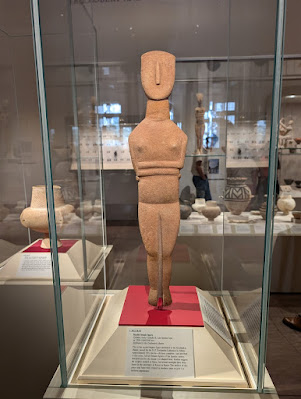Our interest in Cycladic art stems from our visits to Greece in 2010 and 2011. Also from our interests in anything neolithic. Very briefly, the Cyclades are the many islands of the southern Aegean, north of Crete and between mainland Greece and Turkey. The islands have been inhabited for aeons, and Cycladic art is generally compared with Minoan and Mycenean art, from the bronze age. But Cycladic art is much older, some specimens going back into the deeper neolithic, 7,000 years ago. It consists very largely of marble figurines, nearly always female, nearly always in the same standing pose, arms crossed (usually left over right), devoid of any but the largest features. In age they range over several thousand years, and have been found all over the region, nearly always in burial sites, both male and female sites, always reclining, often broken into pieces. Evidence of paint has been found on many. Art historians have identified several different ages and styles of these figures.
But that is absolutely all that is known. There has been much speculation about the purposes and functions of these figurines, but, as with anything about the neolithic, and beyond, it can never be anything more than speculation. Which gives rise to one of the first principles of anthropology: whenever you are utterly clueless about something's meaning or function, say it is "ceremonial." But I digress.
The Met has the largest and most impressive collection of Cycladic art we have seen, outside of Greece. (The British Museum's Cycladic room was closed during our last several visits). What is pictured here is just the Leonard Stern Collection. The Met has more in the Greek/Roman study hall upstairs and still more in the still-closed Rockefeller collection.
 |
| Helpful map of the immediate region |
 |
Among several display cases; Cycladic clay is said to have been of
poor quality, so there isn't much in the way of pottery |
 |
An unusual specimen, headless, arms not crossed, with thigh-pads, and a "voluminous" posterior |
 |
| Voluminous |
 |
| Me and mini-me? |
 |
| Pregnant? |
 |
| Very rare...a musician |
 |
| One of several relatively large specimens |
 |
| Cycladic silver bowls, c. 3,000BCE |
 |
| Terracotta vase for multiple offerings, c. 2,000BCE |
 |
| Comfy chair |
 |
The largest of the collection, perhaps 4 feet high; alas,
only the torso is original, the head and legs modern
additions...oh well... |






































































